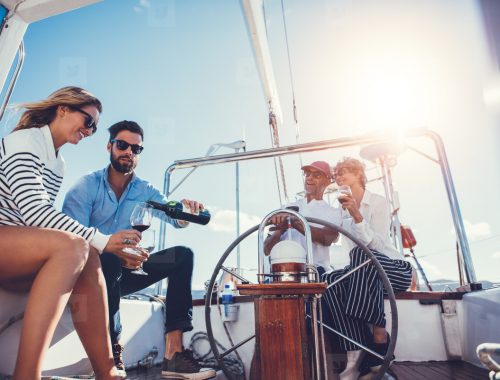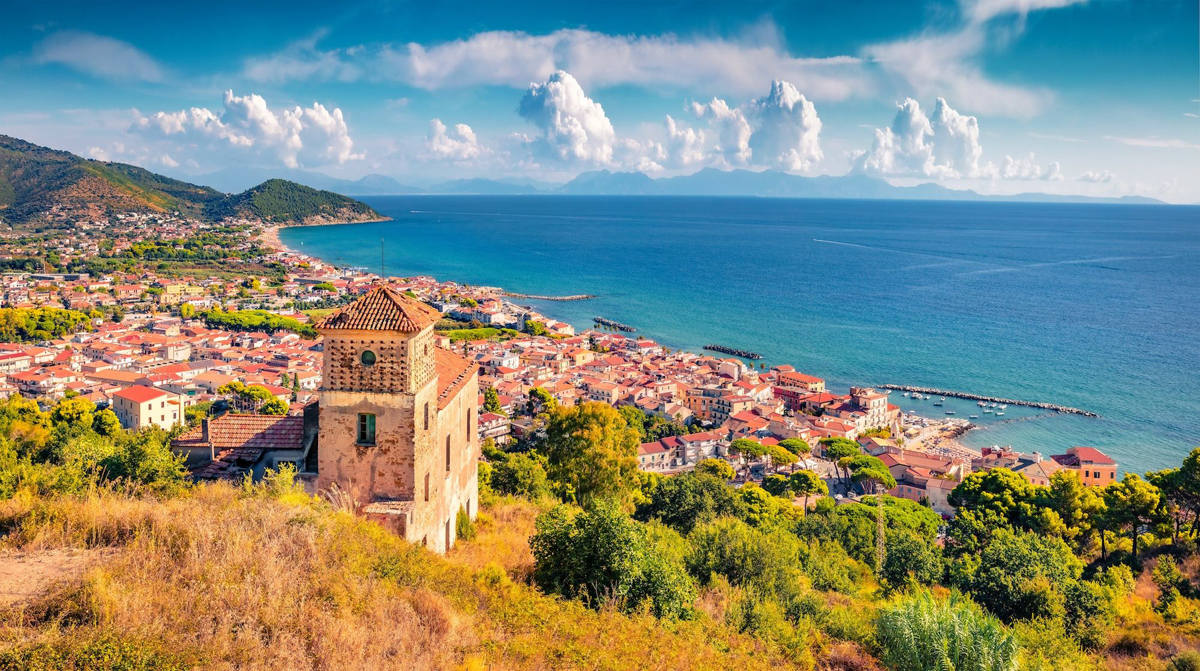
Sailing along the Cilento Coast, between charming villages and dreamlike bays
For those who love unspoiled stretches of coastline, rich in natural beauty and historic seaside villages, the Cilento Coast in southern Campania is an ideal destination for a sailing cruise. This enchanting 50-mile stretch of coastline, nestled between sea and mountains in the province of Salerno, is a UNESCO World Heritage Site. It offers unique landscapes dotted with lush green bays, beaches accessible only by boat, cliffs, promontories, and picturesque fishing villages surrounded by significant archaeological sites. The entire Cilento Coast is part of a protected National Park, home to extraordinary natural wonders and rich biodiversity.
In our 7-day itinerary, we’ll set sail from the historic town of Agropoli, with its lively old harbor, and head towards Acciaroli and the majestic Capo Palinuro. From there, we’ll anchor at Marina di Camerota, a peaceful haven for sailors. We’ll continue on to Scario, one of Campania’s most beautiful villages, overlooking the Gulf of Policastro. Lastly, we’ll visit Maratea, known for its breathtaking views.
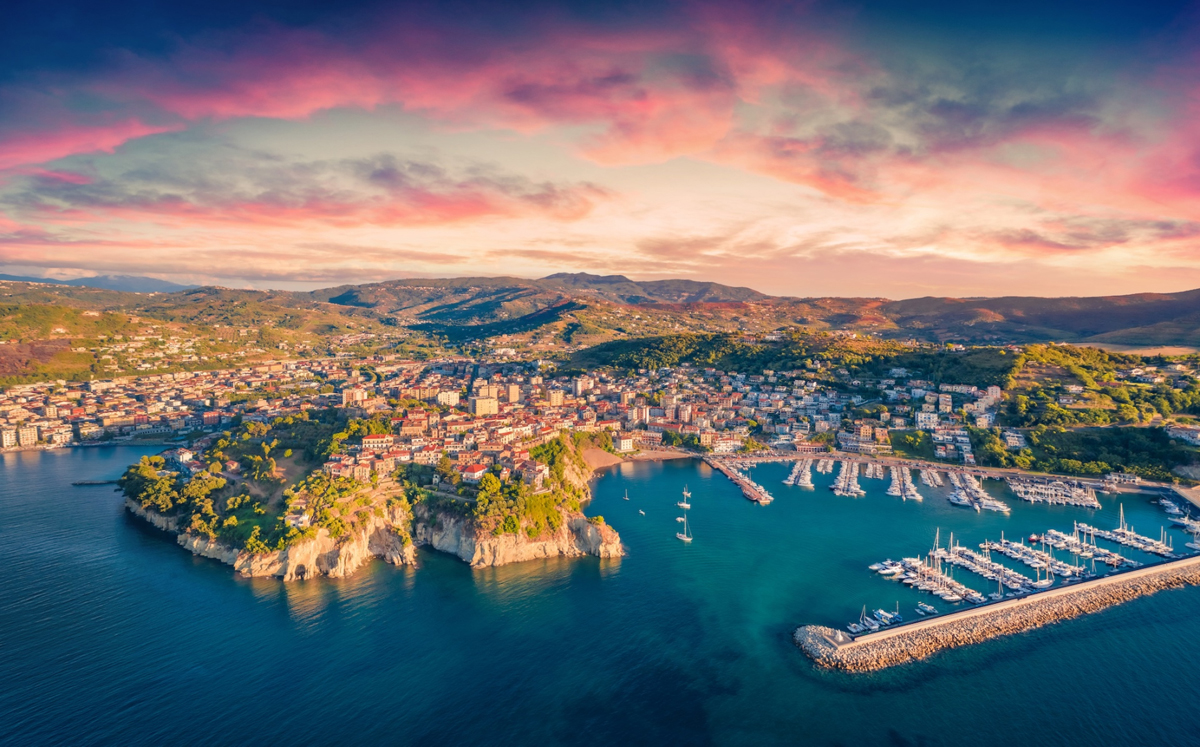
Day 1 – Agropoli, Boarding
Our embarkation point for this cruise along the Cilento Coast is the Port of Agropoli, a modern and secure marina with 1,100 berths, located just steps away from the picturesque old town of this stunning seaside village—right on the border between the Cilento Coast and the Gulf of Salerno. At the heart of the town lies a magnificent 17th-century gate, which leads to a maze of narrow alleys, medieval buildings, defensive walls, ancient watchtowers, houses carved into the rock, and steep stairways that seem to plunge directly into the blue sea below. As its name “Akropolis” suggests, this ancient citadel was once a colony of Magna Graecia and today serves as the gateway to the Cilento National Park and the southern Campanian coastline.
Just beyond its impressive walls lies the charming old village, full of flowers, winding streets, artisan workshops, cozy taverns serving local cuisine, and historic churches such as the 16th-century Church of Santa Maria di Costantinopoli, or the Church of Saints Peter and Paul, home to several notable paintings.
When it comes to beaches, the most famous is the enchanting Baia di Trentova, whose name, according to legend, comes from the 30 seagull eggs once found there. Connected to the mainland by a narrow strip of land, the bay is surrounded by pristine nature. With its distinctive rock, scenic views, and crystal-clear waters, it’s a favorite among sailors. Not far from here is the small Baia di San Francesco, recognizable by a striking rock in the sea with a cross planted on top. For those seeking a more secluded spot away from the summer crowds, the Baia del Vallone is the perfect retreat.
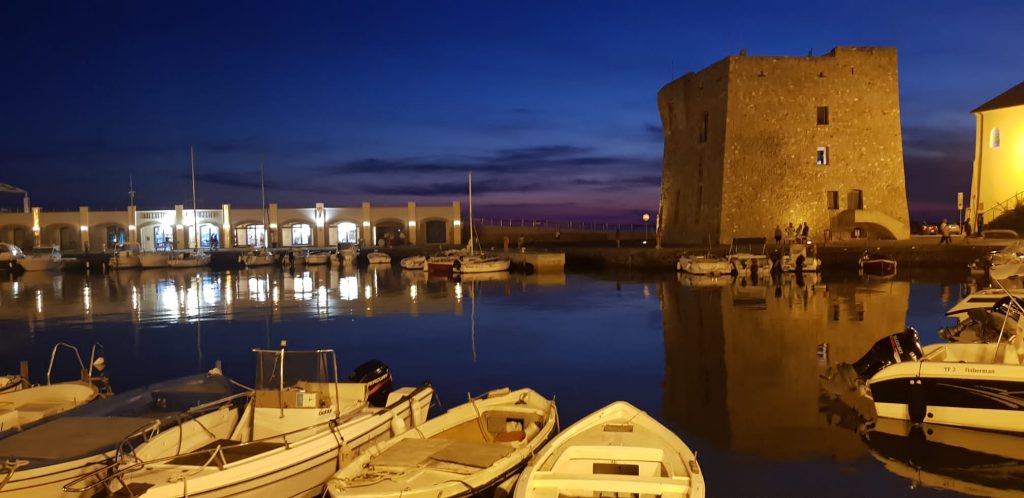
Day 2 – Agropoli to Acciaroli, 17.5 nautical miles
The first stop on our cruise is Acciaroli, a charming stone-built fishing village renowned for its crystal-clear waters and stunning beaches—so much so that it has earned the nickname “Pearl of Cilento.” Acciaroli also gained international fame thanks to the American writer Ernest Hemingway, who first discovered the town during World War II. Between 1950 and 1953, Hemingway returned to Acciaroli and met a local fisherman named Antonio Masarone, known as “’u vecchio” (the old man). This encounter is said to have inspired his literary masterpiece The Old Man and the Sea.
The town’s marina offers 350 berths for boats up to 25 meters, with sandy seabeds and depths ranging from 1 to 5 meters. It provides good shelter from Scirocco winds but is exposed to the Libeccio. Alternatively, you can anchor in the nearby Baia di Ogliastro or Baia di Pioppi.
Acciaroli’s historic center, dating back to the Middle Ages, is a true gem—characterized by stone buildings, artisan shops, colorful houses with flower-filled balconies, and restaurants serving traditional local dishes. Highlights include the Church of the Annunciation and the Norman Tower, both iconic symbols of the town.
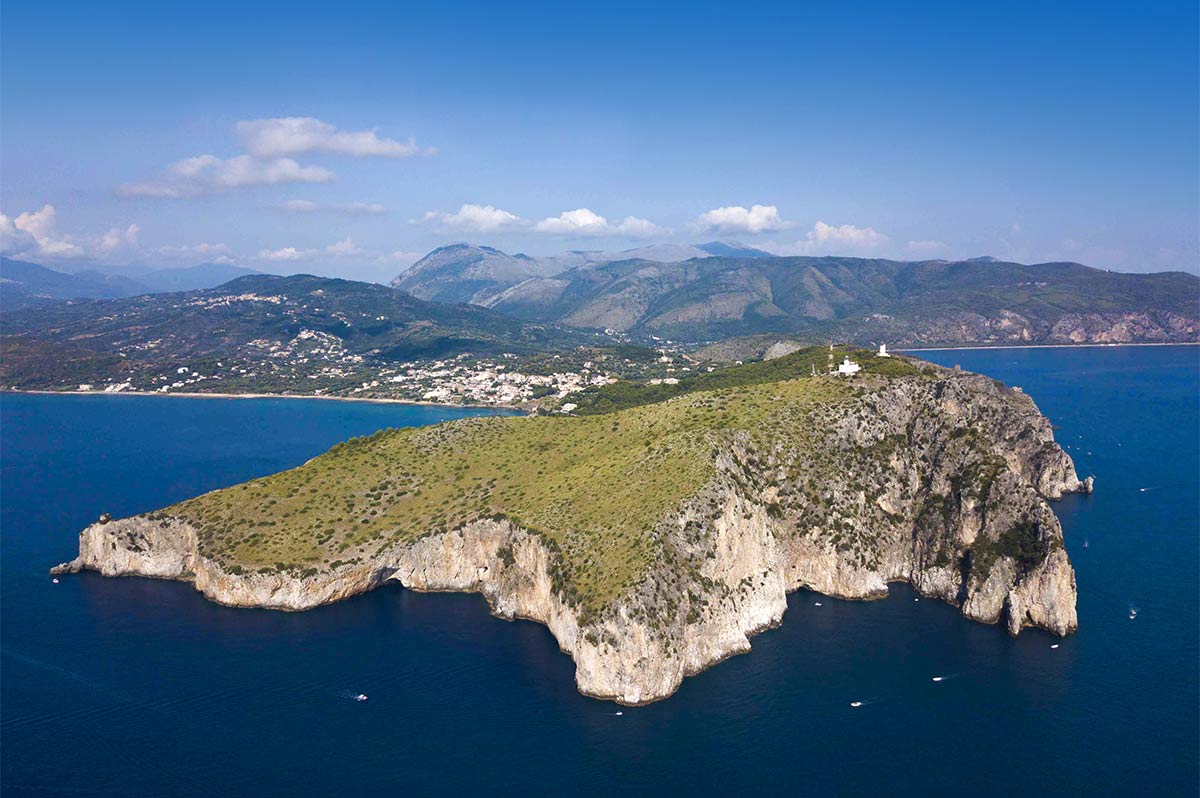
Day 3 – Acciaroli to Capo Palinuro, 7 nautical miles
We set sail in the morning toward Capo Palinuro, one of the most spectacular destinations on the Cilento Coast. Located between the Gulf of Velia and the Gulf of Policastro, it’s instantly recognizable from the sea thanks to its unique pentadactyl shape—like an open hand reaching into the water, with cliffs rising up to 50 meters high. It’s safe to sail close to the cape, as there are no hidden rocks. At its peak sits a weather station and the iconic lighthouse. The headland is rich in both submerged and above-water caves—32 in total, including several natural caverns.
One of the most famous is the Blue Grotto (Grotta Azzurra), which has two underwater entrances 90 meters apart and reaches a depth of 33 meters. The cave is truly magical: upon entering, the water surface to the right glows a brilliant blue that reflects onto the walls and ceiling of the chamber.
Other intriguing caves include the Grotta del Sangue, named for the reddish hue of its rocks; the Grotta delle Ossa, also called the “Prehistoric Cave,” which was once used as a communal burial site and still contains fossil and bone remains; and the Grotta dei Monaci, known for its limestone formations that resemble monks gathered in prayer. Then there’s the Silver Cave (Grotta d’Argento) and Cala Fetente, both home to natural sulfur springs.
A must-see stop is the Baia del Buondormire, accessible only by boat. Its name—”Good Sleep Bay”—comes from the fact that parts of it are always shaded, offering a cool, restful haven. Just offshore, a distinctive rock formation rises from the sea, said to resemble a rabbit.
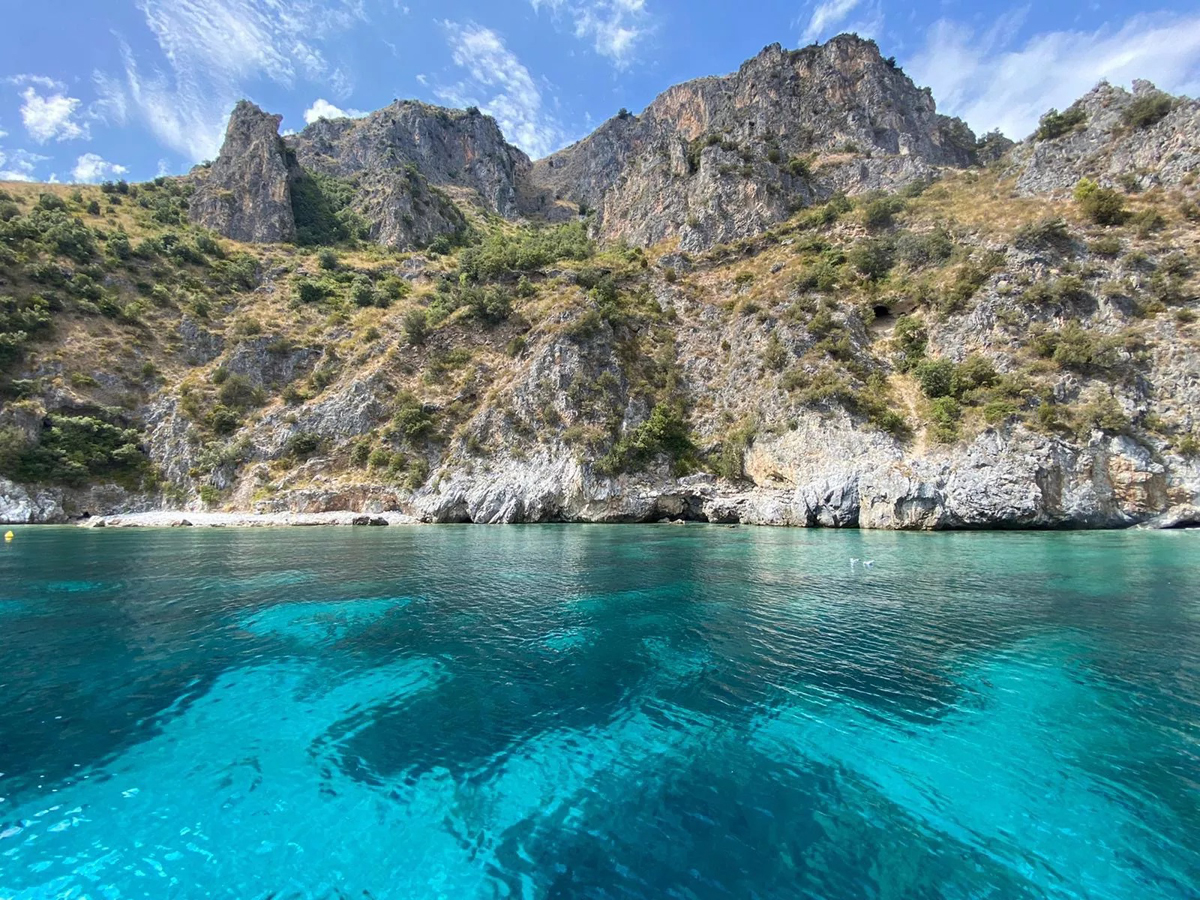
Day 4 – Capo Palinuro to Marina di Camerota, 5 nautical miles
We continue our cruise toward Marina di Camerota, a stunning seaside village perched on Mount Bulgheria and located within the Cilento, Vallo di Diano and Alburni National Park. The name “Camerota” originates from an ancient Greek legend: Palinurus, the helmsman of Aeneas’ fleet, fell in love with the nymph Kamaraton, who cruelly rejected him. As punishment for her harshness, Aphrodite turned the nymph into stone—said to be the very mountain on which Camerota now stands.
There are two mooring options here. One is to dock at the Marina di Camerota harbor, which allows you to experience the vibrant life of the village. The marina offers 300 berths for boats up to 35 meters, with sandy bottoms and depths ranging from 1 to 4.5 meters. It offers excellent shelter from westerly winds. A romantic walk along the pier leads to the small harbor lighthouse. Alternatively, you can anchor in Baia degli Infreschi, where mooring buoys are available. This small bay features a mix of sand and pebbles and has deep, clear waters.
The heart of Marina di Camerota’s old town is Piazza San Domenico, from which a network of narrow lanes filled with bars, shops, and restaurants unfolds. Notable sights include the Castello di Marina, built in the late 1600s, and the Saracen Towers (also known as “Telegraph Towers”), defensive structures dating back to the mid-16th century. Also worth visiting is the Virtual EcoMuseum of the Paleolithic, which displays artifacts and remains from Bronze Age settlements.
Marina di Camerota is also famous for its beautiful beaches—Lentiscelle, Calanca, and Cala Bianca—some of which are wild and untouched. The area is also rich in karst caves, where fossils and prehistoric bones have been found, and which offer breathtaking diving experiences.
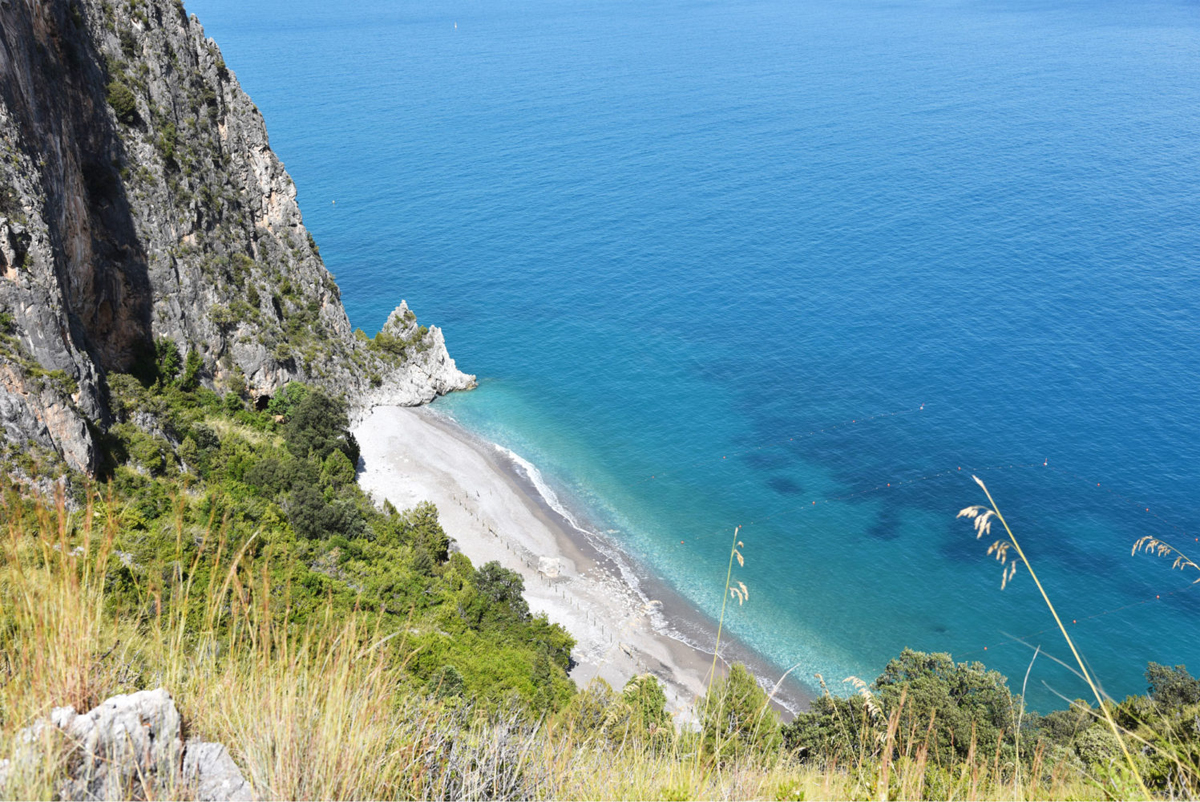
Day 5 – Marina di Camerota to Scario, 8.7 nautical miles
We set our course once again toward the horizon, heading to Scario, one of the most enchanting fishing villages along the Cilento Coast, overlooking the crystal-clear waters of the Gulf of Policastro. This picturesque former fishing hamlet, now a small district of San Giovanni a Piro, is surrounded by numerous coves, inlets, and dreamy beaches—such as the renowned Spiaggia dei Francesi and the Garigliano anchorage, both excellent spots for dropping anchor. The good news for sailors is that the main beaches along the Costa della Masseta can only be reached by sea. Low development in the area, combined with its protected park status, has preserved its pristine natural beauty and kept pollution levels remarkably low.
Alternatively, you can moor at the town’s marina, which offers 160 berths on rock and mud seabeds, with depths ranging from 1 to 5 meters. It provides good shelter from westerly winds (though it’s exposed to Scirocco and Grecale) and offers a wide range of services at the dock, including water, electricity, waste disposal, ice, haul-out service, crane, electrical repairs, and boat security.
From the harbor, various excursions depart to unspoiled, magical spots—such as Punta degli Infreschi. The coastline is also dotted with mysterious karst caves, hidden coves accessible only by boat, and imposing watchtowers, ancient sentinels that once guarded the land. The area boasts incredibly rich marine flora and fauna—true natural treasures waiting to be discovered.
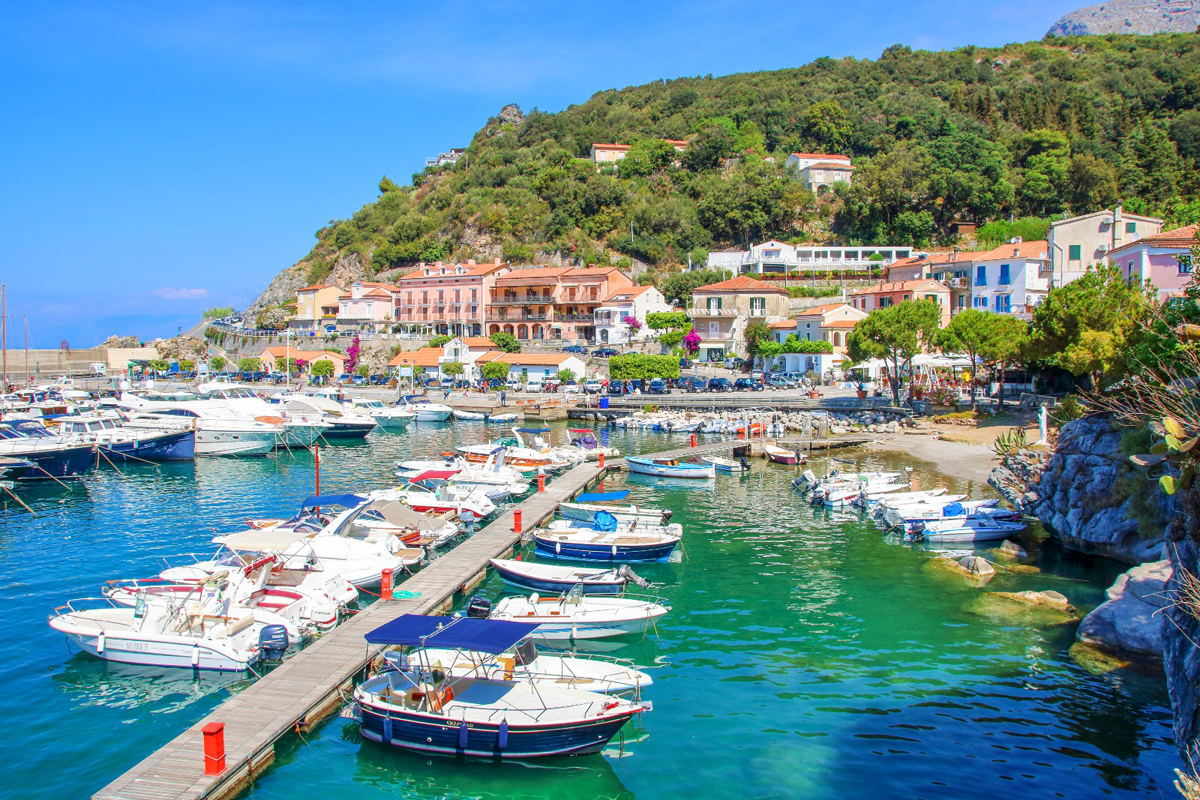
Day 6 – Scario to Maratea, 14 nautical miles
On the sixth day of our cruise, we sail toward the beautiful town of Maratea, perched dramatically on Mount San Biagio and offering breathtaking views over the Gulf of Policastro. As you approach from the sea, you’ll spot the iconic Christ the Redeemer statue, standing 22 meters tall atop the mountain—a vantage point from which you can even glimpse the spectacular Aeolian Islands on a clear day.
Maratea’s harbor lies at the easternmost end of the Gulf of Policastro. Entry is recommended during daylight hours and in calm seas, especially when approaching from the northwest. The marina has 600 berths, 50 of which are reserved for transiting vessels. The seabed consists of rock and sand, with depths ranging from 2 to 8 meters. The closest safe anchorages are in the ports of Sapri and Cetraro.
The historic center of Maratea retains its medieval layout, with narrow streets and significant architectural landmarks. Known as the “City of 44 Churches,” Maratea is home to numerous churches, hermitages, chapels, and monasteries scattered throughout the area—many adorned with remarkable works of art and open to the public. Its beaches, tucked between rugged headlands and surrounded by lush vegetation and clear waters, are another highlight. For nature lovers, the nearby Pollino National Park offers excellent hiking opportunities.
Day 7 – Maratea to Capo Palinuro to Agropoli, 48 nautical miles
Our sailing journey along the Cilento Coast comes to an end as we make our way back to our starting point in Agropoli. With a full day of sailing ahead, there’s still time to enjoy this romantic stretch of coastline—filled with beauty for the eyes, joy for the heart, and flavors for the palate. Perhaps, as we cruise along, we’ll already be dreaming of returning someday… always aboard a sailboat.
You May Also Like

Sailing in the western Cyclades Islands
15/11/2021
Alicudi: embracing the gentle rhythm of time on the island of steps
29/11/2023